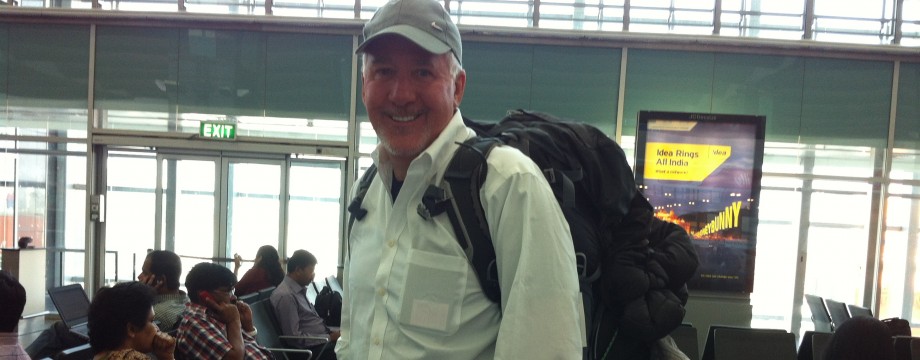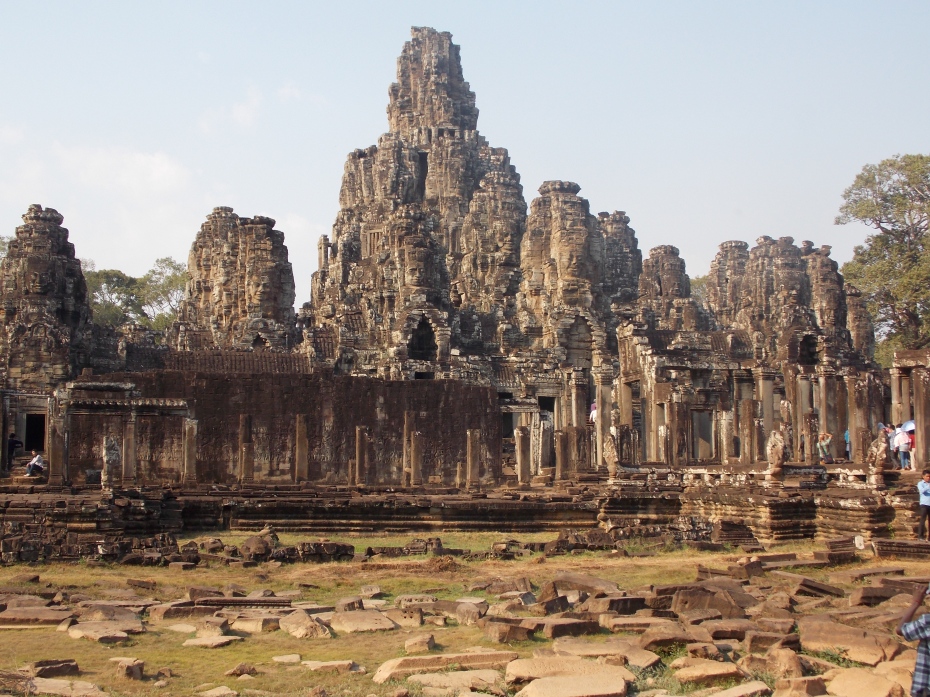From Phnom Penh it was a seven-hour bus ride north to Siem Reap, which is home to the great Angkor temple complex and the reason most people come to Cambodia.
According to Wikipedia, in 2007 an international team of researchers using satellite photographs and other modern techniques concluded that Angkor had been the largest preindustrial city in the world, at least 390 square miles and supporting up to one million people. Its closest rival, the Mayan city of Tikal in Guatemala, was no more than 58 square miles in total size. In its glory Angkor contained more than 1000 temples, the oldest dating back to the 6th century; ruins that remain today are from between the 9th and 12th centuries. It served as the capital of the Khmer Empire from the 9th to 14th centuries, but in the 15th century an Ayutthayan army from Siam captured Angkor, driving the population south and destroying the city. The capital was moved to Phnom Penh and the massive Angkor complex became deserted and overgrown.
The story has it that a Frenchman, with guidance from a local monk, rediscovered Angkor in 1860. I did overhear one guide say this: “He didn’t rediscover it, he just re-publicized it. It had been here all along as home to monks, and many Japanese and Chinese and Vietnamese people knew it was here.” But I prefer imagining this guy and his monk buddy hacking their way through the jungle with machetes and stumbling upon these incredible temple ruins, in the ultimate Indiana Jones moment.
The first afternoon we visited the ruins of Angkor Thom, “Big City”. In its day it was three square kilometers, with a 12-kilometer moat and 57 towers. The ruins are quite striking and there are areas where the stone is much lighter because the Japanese government has paid for restoration. There are faces built into the stones, and a prevalent theory is that they are a combination of the stern visage of the king who built the temple and the benevolent face of Buddha.
First thing the next morning we visited the magnificent Angkor Wat, the largest religious monument in the world. It was built between 1113-1150 by king Suryavarman II, employing 300,000 men and 3,000 elephants. It was originally a Hindu temple dedicated to the god Vishnu, and is still a functioning religious center but now it is Buddhist; there were a number of shrines within the ruins where Buddhists had come to pray amidst the thousands of tourists.
After entering through the west gate, the king’s gate, I left my group and walked to the far side of the compound to the east gate, where the commoners used to enter. It was shaded and peaceful there, with far fewer people, a couple of lakes and a family of monkeys. With the sun behind me I tried to get some interesting angles on the five main towers, which are shaped like lotus flowers that have yet to blossom. Angkor Wat definitely does not disappoint; it is a powerful place that captures the imagination and takes you back 1000 years, in wonderment of what this unique and sophisticated civilization must have been like, and what it might have become.
There is a market (of course there is) adjacent to the temple within the grounds. At a small café’ each table is named for a celebrity: John Rambo, Harry Potter, Lady Gaga, Angelina Jolie, James Bond … and Tiger Wood. I asked the guy hustling me why they did that. He said: “Maybe if people see person they like, they stay to eat.” I asked if it worked and he just shrugged. I didn’t correct him on the spelling of Tiger’s name; I was just amused that his popularity has reached as far as the jungles of northern Cambodia.
Later we went to the Tomb Raider temple, so called because the Angelina Jolie movie of that name was filmed there in 2001. The resulting publicity and traffic have taken a toll and much of the grounds are under construction and renovation.
We had two evenings to enjoy the city of Siem Reap (“The Defeat of Siam”), which has 300,000 permanent inhabitants and receives 3.5 million visitors per year. There is a terrific night market no more than a ten-minute tuk tuk ride from wherever your hotel is; the streets are alive with bars and restaurants, clothing and art shops, every conceivable accent and dozens of massage places on the street, where you can get incredible 15-minute foot massages for a dollar.
The more interesting massage is called Doctor Fish. You sit on the edge of a large fish tank filled with one- to three-inch garra rufa fish, also known as the reddish log sucker, nibble fish and physio fish. You recoil half a dozen times from the tickling before you can completely commit. Supposedly they are eating only the dead skin and cleaning off the dirt, and afterwards your feet do feel smoother, but it’s not the most comfortable sensation. It’s a dollar for ten minutes, and for two dollars you get 20 minutes and a free beer, quite a deal, and when you are with four other friends it’s a definite hoot. When I researched it later I discovered that certain agencies have called for the practice to be banned, believing that it could spread viruses like Hepatitis, which sounds like a bunch of BS to me.
But I don’t think I’ll tell the others.















You must be logged in to post a comment.